You need to reapply diatomaceous earth after rainfall because water transforms the fine, sharp powder into ineffective clumps that can’t cut through insect exoskeletons or absorb their protective waxy coating. Rain also washes DE away completely, creating gaps in your pest control coverage. The moisture binds particles together, reducing surface area contact and dulling the silica edges essential for dehydrating insects. Understanding proper reapplication timing and techniques will maximize your pest control investment.
How Rain Affects Diatomaceous Earth Effectiveness
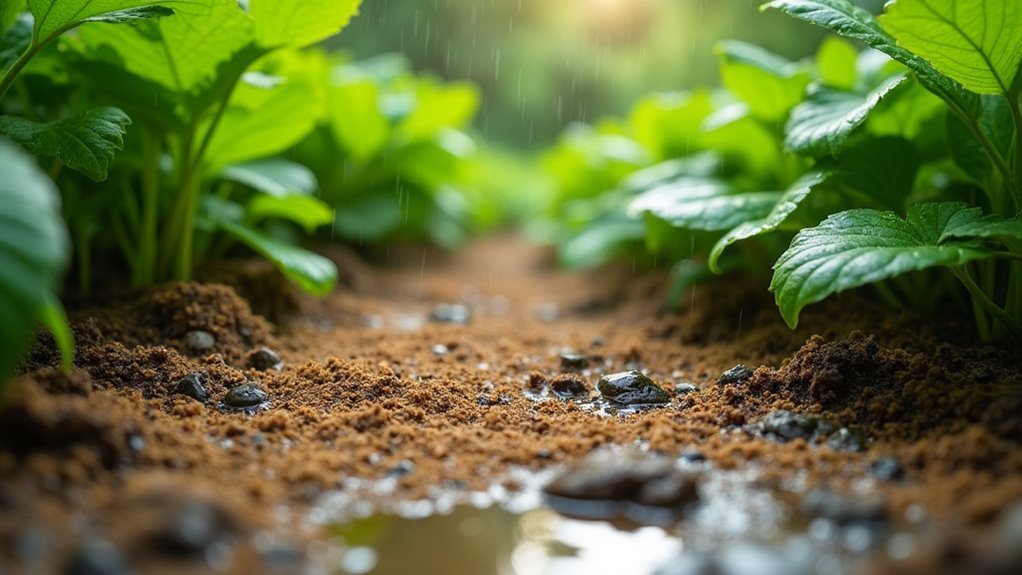
When rain hits your diatomaceous earth application, it immediately compromises the product’s pest control abilities. The moisture causes the fine powder to clump together, eliminating its vital abrasive properties that make it lethal to insects.
You’ll notice the diatomaceous earth loses its dust-like consistency and becomes ineffective at cutting through pest exoskeletons.
Rain’s lightweight nature easily washes away your carefully applied DE, leaving gaps in coverage where pests can freely move.
Even if some product remains after rainfall, the wet clumps won’t provide the protective barrier you need.
While diatomaceous earth can regain effectiveness after drying, you must reapply it to restore proper coverage.
Without that visible, dry layer blanketing your target areas, you’re fundamentally unprotected against returning pests.
The Science Behind Moisture and DE Performance
Understanding the molecular structure of diatomaceous earth reveals why moisture renders this pest control method ineffective.
When water contacts DE’s microscopic silica particles, it creates a smooth surface that can’t penetrate insect exoskeletons. The sharp, abrasive edges essential for cutting through protective shells become rounded and useless.
Here’s how moisture impacts Diatomaceous Earth Application:
- Particle Clumping – Water binds individual particles together, reducing surface area contact with pests.
- Edge Dulling – Moisture smooths the razor-sharp silica edges that cause fatal dehydration in insects.
- Physical Displacement – Rain washes away powder entirely, eliminating coverage zones.
You’ll need to reapply after any significant moisture exposure.
Even light humidity can compromise effectiveness, making visual inspection vital for maintaining pest control barriers.
Signs Your Diatomaceous Earth Needs Reapplication
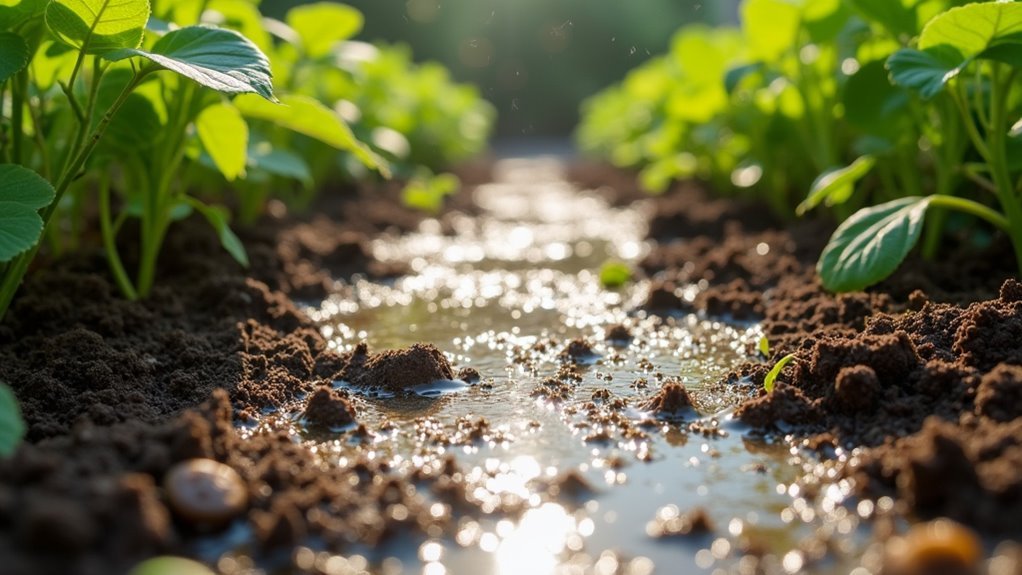
You’ll know it’s time to reapply diatomaceous earth when you can no longer see the white powder coating in areas where you originally applied it.
If pests start returning to plants or structures that were previously protected, this signals that your DE barrier has likely been compromised.
These visual and behavioral cues are your clearest indicators that moisture has either washed away or clumped your diatomaceous earth, making reapplication necessary.
Visual Powder Disappearance
One of the clearest indicators that your diatomaceous earth needs reapplication is when you can no longer see the fine white powder where you originally applied it. This visual disappearance signals that environmental factors have compromised your pest control barrier.
When checking your application areas, look for these telltale signs:
- Complete absence of white powder on leaf surfaces, soil, or treated areas where you previously applied DE
- Clumped or darkened residue that no longer resembles the original fine, white dusting
- Bare spots in your garden beds or around plants where the powder has been washed or blown away
Since diatomaceous earth requires visibility to maintain effectiveness, immediate reapplication becomes necessary once you notice these visual changes in your treated areas.
Returning Pest Activity
Beyond these visual cues, you’ll notice pest activity returning to previously treated areas as another clear signal that your diatomaceous earth application has lost its protective power.
Aphids clustering on plant stems, ant trails reestablishing through garden beds, or crawling insects moving freely across surfaces where D.E. once provided effective pest control all indicate compromised protection.
When you spot new infestations appearing in zones you’d previously treated, it’s time for immediate reapplication.
Fresh plant damage, increased insect movement, or pests congregating around vulnerable areas suggest your barrier has been washed away or rendered ineffective.
Don’t wait for heavy infestations to develop—reapply diatomaceous earth as soon as you detect returning pest activity to restore your garden’s protective shield.
Optimal Timing for Post-Rain Reapplication
While diatomaceous earth becomes ineffective the moment it gets wet, timing your reapplication correctly guarantees you’ll maintain consistent pest control without wasting product.
You’ll want to wait until surfaces are completely dry before spreading fresh DE, as applying it to damp areas reduces its lacerating capabilities.
Follow these timing guidelines for maximum effectiveness:
- Wait 24-48 hours after rainfall to verify complete moisture evaporation from all surfaces
- Apply during dry weather periods when no rain is forecasted for at least 24 hours
- Monitor weekly in high-rainfall regions to determine when diatomaceous earth needs to be re-applied
In areas experiencing frequent storms, you’ll need monthly reapplications to maintain protection levels.
Regular monitoring helps you identify when pest activity increases, signaling that your diatomaceous earth requires revitalizing.
Weather Conditions That Impact DE Longevity
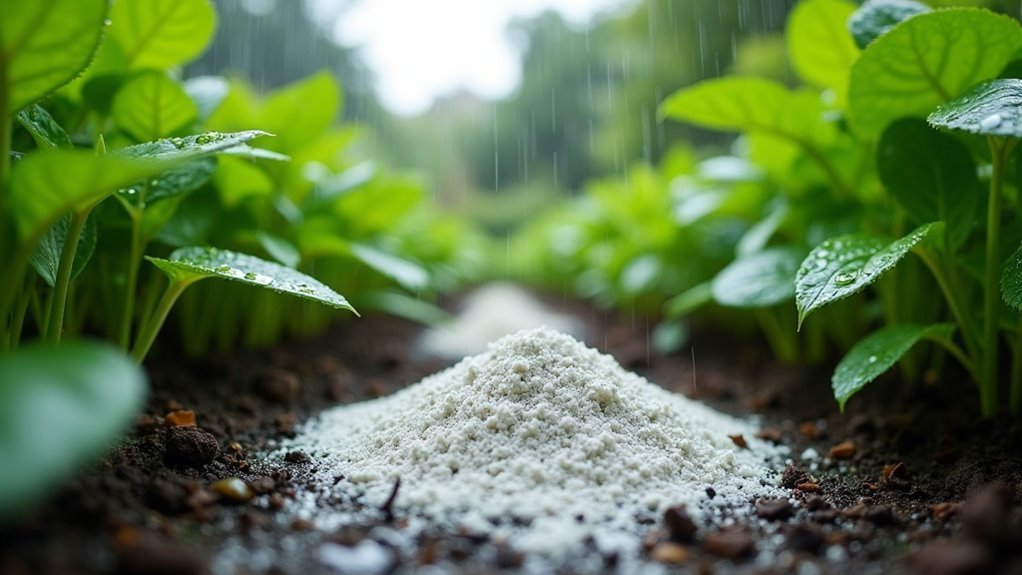
Several weather factors determine how long your diatomaceous earth application will remain effective in the field. Understanding these conditions helps you plan when DE needs to be re-applied for ideal pest control.
| Weather Condition | Impact on DE Longevity |
|---|---|
| Heavy Rainfall | Washes away application completely |
| Light Drizzle | Creates clumping, reduces effectiveness |
| High Humidity | Causes moisture absorption, diminishes powder quality |
| Strong Winds | Disperses DE from target areas |
| Frequent Rain Cycles | Requires regular monitoring and reapplication |
Moisture is DE’s primary enemy, whether from precipitation or atmospheric humidity. You’ll need to inspect application areas regularly and reapply when the white powder coating becomes invisible. In consistently rainy climates, expect more frequent applications to maintain continuous pest protection throughout the growing season.
Application Techniques for Maximum Rain Resistance
Although diatomaceous earth naturally washes away in rain, you can greatly improve its staying power by adjusting your application methods.
Proper technique markedly reduces how often you’ll need to re-apply after storms:
- Apply as a light dusting – Thin, even layers adhere better to surfaces and resist displacement better than thick applications that easily wash away.
- Mix with binding agents – Combine D.E. with natural binders or apply it wet to create a protective layer that maintains effectiveness once dried.
- Use targeted application tools – Employ recycled shaker canisters for precise placement in protected areas where rain exposure is minimal.
Monitor treated areas after rainfall and reapply when the powder becomes invisible or pest activity resurfaces.
Cost Considerations of Frequent Reapplication
You’ll need to factor frequent reapplication costs into your pest control budget, especially if you live in a rainy climate where monthly applications become necessary.
Consider exploring alternative application methods like mixing DE with adhesive agents or protective coverings that can extend its effectiveness between storms.
Understanding the long-term economic impact helps you decide whether combining DE with other pest management strategies makes more financial sense than relying solely on repeated applications.
Budget Planning Strategies
When rainfall frequency increases in your area, diatomaceous earth reapplication costs can quickly spiral beyond your initial pest control budget.
Planning ahead helps you maintain effective pest management without financial strain.
Smart budget planning requires calculating how often DE needs to be re-applied based on your local weather patterns. In high-rainfall regions, you’ll face monthly applications that accumulate significant expenses over time.
Consider these budget planning strategies:
- Calculate seasonal costs – Estimate total DE purchases needed for your growing season based on rainfall frequency
- Integrate alternative methods – Combine DE with other pest control techniques to reduce overall cost
- Buy in bulk – Purchase larger quantities during sales to lower per-application expenses
Factor in monitoring time and replacement costs when developing your pest control budget for sustainable, long-term effectiveness.
Alternative Application Methods
Beyond careful budget planning, exploring alternative application methods can dramatically reduce your long-term costs while maintaining effective pest control.
You can stretch your diatomaceous earth supply by combining it with homemade sprays or natural deterrents, reducing reliance on frequent standalone applications. Consider creating barrier applications in strategic locations rather than broadcasting across entire areas. This targeted approach uses less DE while maintaining effectiveness against aphids and ants.
You’ll also benefit from timing applications strategically – applying immediately after rainfall when pest activity peaks maximizes impact.
Mixing used DE with complementary organic methods like beneficial insects or companion planting creates a thorough system. These alternative approaches help you maintain pest management without constantly reapplying Earth after every weather event, ultimately protecting your budget while preserving garden health.
Long-term Economic Impact
While diatomaceous earth appears cost-effective initially, frequent reapplication after rainfall creates mounting expenses that can strain your gardening budget over time.
DE’s lightweight composition makes it vulnerable to washouts, requiring consistent repurchasing to maintain pest control effectiveness. In rainy regions, you’ll likely need monthly applications, causing costs to accumulate rapidly.
Though your initial investment seems economical, these long-term costs often exceed alternative pest control methods requiring less frequent application.
Consider these financial realities when DE must be re-applied regularly:
- Monthly reapplication costs – Heavy precipitation areas demand consistent product replacement
- Cumulative expense buildup – Ongoing purchases greatly outweigh initial savings over seasons
- Budget strain comparison – Long-term costs typically surpass one-time investments in alternative pest management solutions
Balancing DE with other techniques helps mitigate excessive spending while maintaining effective pest control.
Monitoring Your DE Treatment Areas
After applying diatomaceous earth to your target areas, you’ll need to establish a regular monitoring routine to confirm the treatment remains effective.
Check for visible powder presence on plants, soil, and surrounding surfaces. When DE becomes less visible to the naked eye, it’s time to reapply for continued pest control.
Focus your monitoring efforts on outdoor applications, especially in areas prone to heavy rain or wind.
These environmental factors can displace the powder and necessitate frequent reapplication. Inspect treated zones after rainfall or significant moisture events to determine if the powder has washed away.
Regular monitoring confirms DE maintains its abrasive and dehydrating effects against pests, keeping your treatment zones protected and functional.
Seasonal Reapplication Strategies
Building on your monitoring observations, you’ll need to adapt your reapplication schedule based on seasonal weather patterns and pest activity cycles. Each season presents unique challenges when using diatomaceous earth effectively.
1. Spring/Summer: During rainy seasons, you’ll need to re-apply D.E. more frequently due to frequent moisture exposure.
Plan weekly inspections and be prepared for immediate reapplication after storms.
2. Fall: As temperatures drop, pest activity decreases, but you should maintain monthly applications to prevent overwintering insects from establishing shelter areas.
3. Winter: While pest pressure is minimal, strategic placement in protected areas guarantees you’re ready for emerging spring pests without starting from zero coverage.
Wind displacement during storms also requires prompt reapplication regardless of season.
Frequently Asked Questions
Does Diatomaceous Earth Need to Be Reapplied After Rain?
Yes, you’ll need to reapply diatomaceous earth after rain. Water washes away the powder, making it ineffective against pests. You should monitor treated areas and reapply whenever the powder’s no longer visible.
Does Diatomaceous Earth Still Work After It Gets Wet?
Diatomaceous earth doesn’t work effectively when wet because moisture causes it to clump and lose adhesion to pests. You’ll need to let it dry completely, then reapply for ideal pest control results.
Do You Need to Reapply Diatomaceous Earth After Watering?
Yes, you’ll need to reapply diatomaceous earth after watering. Water washes away or displaces the fine powder, reducing its effectiveness against pests. Reapply once the area’s completely dry for best results.
Does Diatomaceous Earth Lose Its Potency?
Diatomaceous earth doesn’t lose its potency permanently, but moisture temporarily reduces its effectiveness. Once you let it dry completely, it’ll regain full strength. You’ll need to reapply if it’s washed away.
In Summary
You’ll need to reapply diatomaceous earth after rain because moisture reduces its effectiveness considerably. Water causes DE particles to clump together, making them less abrasive to pests. You should check your treated areas within 24-48 hours of rainfall and look for signs like reduced powder visibility or clumping. Don’t wait too long—reapply when conditions are dry for ideal pest control results and protection.

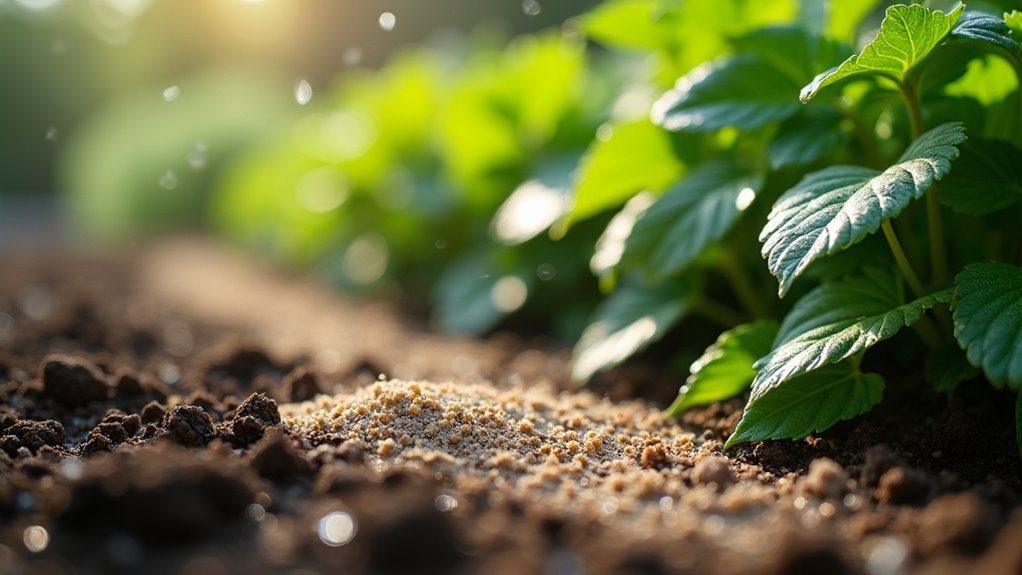
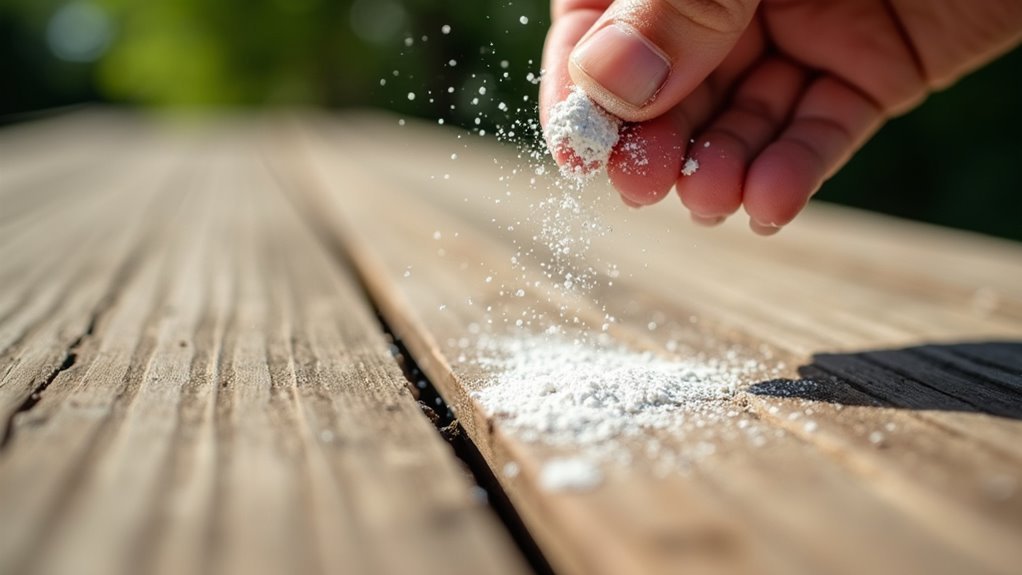
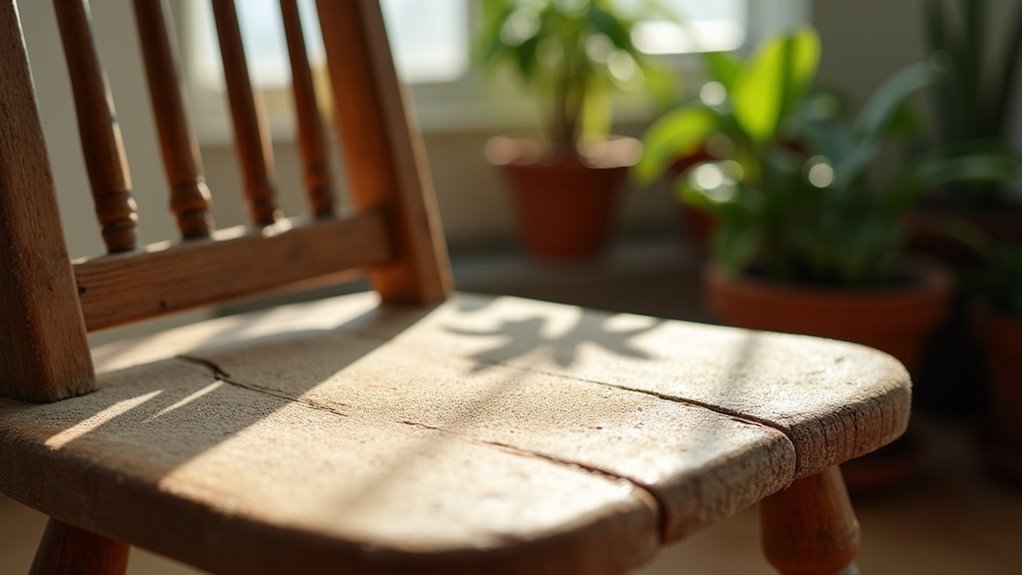
Leave a Reply